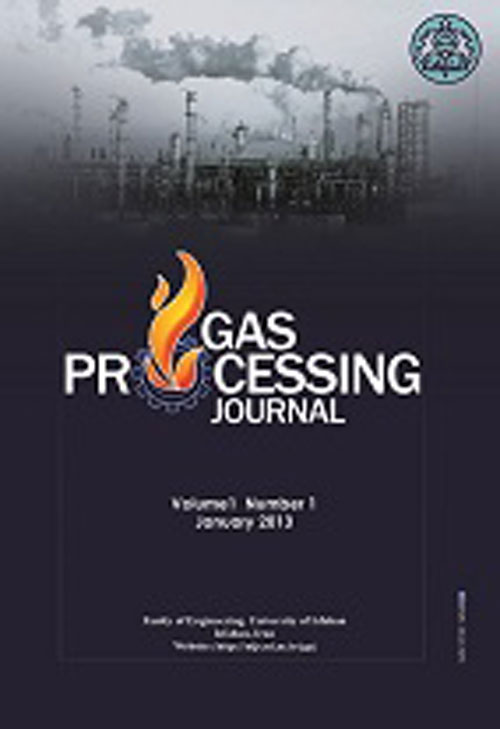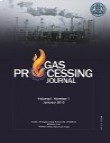فهرست مطالب

Gas Processing Journal
Volume:7 Issue: 1, Winter 2019
- تاریخ انتشار: 1397/10/11
- تعداد عناوین: 6
-
-
Pages 1-14
In the present study, exhaust gases from Tehran refinery crude oil furnace are used in a Heat Recovery Steam Generator (HRSG)for generating steam. Then, the steam is directed to a double effect absorption refrigeration cycle to produce cooling. To meet the object, mass and energy balance equations of the coupling is carried out for both the HRSG and the absorption chiller and unknown thermodynamic parameters of the system are evaluated. Afterward, by conducting exergy analysis and using the thermoeconomic method, the cost of the product (refrigeration here) is calculated. Finally, optimization is accomplished simultaneously on both HRSG and absorption chiller in order to minimize the cooling cost by the means of a Genetic algorithm. The outcomes indicate that by using the optimized integrated system 5627 tons of refrigeration is obtainable at the price of 0.0104 (USD per second). Since the flue gas was wasting to environment pricelessly, it should be noted that by implementing the proposed coupling 1.186×107</sup>cubic meter of natural gas with the price of 1.508×106</sup>(USD) will be saved annually.
Keywords: Heat Recovery Steam Generator (HRSG), Double effect absorption chiller Exergy analysis, Thermoeconomic optimization, Genetic algorithm -
Pages 15-28
This paper aims to introduce a constructive method for optimizing the supply of freshwater and wastewater in the process industry. Different conceptual methods such as Composite Table Algorithm (CTA), Extended Composite Table Algorithm (ECTA), Composite Matrix Algorithm (CMA) have been investigated to optimize water and wastewater network. Also, Mixed Integer Non-Linear Programming (MINLP) as a mathematical and Cuckoo Search (CS) as artificial inelegance approaches have been applied and compared with conceptual methods. In this study, pressure drop calculations and pump cost have been considered as well. In this regard, a computer program has been developed to compute the CTA, ECTA, CMA, and CS approach for a water and wastewater network. The MINLP method has been performed in the APSEN WATER software. A water and wastewater network of a gas refinery has been considered as a case study. Results show that between targeting approaches, the CMA method is a more powerful tool for optimum cost rather than CTA and ECTA. Finally, CMA, CS, and MINLP yield almost similar results. However, CS and MINLP are more time-consuming in comparison with targeting approaches.
Keywords: CTA, ECTA, MINLP, CS, Water Network, Gas Refinery -
Pages 29-40
Over the past few years, researchers were carried out a conscious effort to explore various methods of improving the thermal efficiency of power plants. It was shown that the application of a recuperator is beneficial to improve the thermal efficiency of a gas power plant. Nevertheless, a few studies were done from a thermodynamic point of view and it is safe to say that few numerical simulation studies were performed using computational fluid dynamics. Therefore, in this study, the effect of using a recuperator was investigated to increase the temperature of the combustion chamber inlet air at four different temperatures (633, 643, 663 and 673 K) and to enhance the overall thermal efficiency. Furthermore, the effect of this approach on the emission of pollutants was explored. For this purpose, the compressor and turbine were numerically simulated using a developed MATLAB code while the combustion chamber of the gas power plant was simulated for various pre-heated temperatures in a thermodynamic analysis by ANSYS Fluent 16. The results indicated that in the case of the highest increase in the inlet air temperature to the combustion chamber (50°C) compared to the basic state (without recuperation), the thermal efficiency of the power plant and emission of nitrogen oxides were increased by 1.46% and by 44.17%, respectively.
Keywords: Thermal Efficiency, Nitrogen Oxide, Combustion chamber, Computational Fluid Dynamics -
Pages 41-52
Renewable heat sources are a sustainable and clean way to produce power, heating, and cooling. Combined cooling, heat, and power (CCHP) systems are very promising for producing demands simultaneously. In the present study, a CCHP system with the geothermal source has been investigated, and heat loads are designed for the micro-scale application. To determine the feasibility of the system, energy analysis is carried out, and results are reported after optimization. Also, the genetic algorithm method is presented for optimization. The sub-objectives of this study are the calculations of water usage and CO2 </sub>emission in the manufacturing process. For this matter, energy efficiency, water usage, and CO2</sub> emission after optimization have been examined as three significant parameters. The efficiency of the system, water usage, and CO2</sub> emission are reported as 46.4%, 688151.2 (lit) and 13439 respectively. The total purchase cost is 43121 $. Moreover, the results show that between components the maximum water usage in manufacturing and CO2</sub> emission is belonged to vapor generator with 242010 (lit) and 4701
Keywords: Geothermal, Energy Efficiency, Water Usage, Carbon DIoxide Emission, CCHP, Genetic Algorithm, Optimization -
Pages 53-64
This experimental research aims to investigate the simultaneous effects of fuel injection characteristics on the combustion process in the D87 heavy-duty direct injection diesel engine. In this study, effects of 36 various injection strategies such as spraying pressure (1000, 1200, and 1400 bar), injection timing (6, 8, 10, and 12 CA BTDC), and fuel quantity (45, 90, 120, and 150 mm3</sup> per cycle) on combustion characteristics (MPPP and EGT), emissions formation (NOx and soot), and engine performance (brake power and BSFC) were explored. Results showed that increasing spraying pressure and quantity simultaneous with advancing fuel injection timing led to the increment of both MPPP and EGT and as a result, improvement of BSFC and brake power. However, due to lower AFR, higher combustion temperature, and shorter ignition delay period, both soot and NOx increased, which considered as a disadvantage of using this fuel injection strategy for the D87 diesel engine. In addition to that, for low fuel quantity per cycle (e.g., 45 mm3</sup>) due to shorter spraying duration, fuel injection timing and pressure have a great impact on engine performance because of determining the time of combustion phase and energy loss per cycle.
Keywords: Heavy-Duty Diesel Engine, Injection Pressure, Injection Timing, Air-Fuel Ratio, Emissions -
Pages 65-80
The importance of energy consumption and environmental protection is one of the key issues of the past decade. Most of the energy consumption during the summer season in residential buildings, offices, hospitals, and hotels is related to their chiller plant. The highly variable cooling demand of the buildings connected to a hybrid chiller plant has to be distributed among absorption and vapor compression chillers to achieve higher energy efficiencies. Cooling load sharing strategies in chiller plants have a significant impact on energy consumption and consequently with more productivity and environmentally protected. This paper examines the behavior and pattern of energy consumption in a hybrid chiller plant that includes a combination of vapor compression and absorption chillers. In order to properly understanding the pattern of energy consumption, an existing mechanical room for a hospital in Tehran has been studied for six months and its energy consumption has been compared with the software modeling. This comparison includes the capacity of each chiller, the amount of energy consumed by vapor compression chillers and absorption chillers, and the percentage of their cooling energy allocation. The results indicate that the sequence of the chiller function and how they are placed in the circuit during a partial load is in the highest importance in viewpoint of energy saving.
Keywords: Chiller Plant, Energy Consumption, Sequence of Operation, Time of Partial Load


